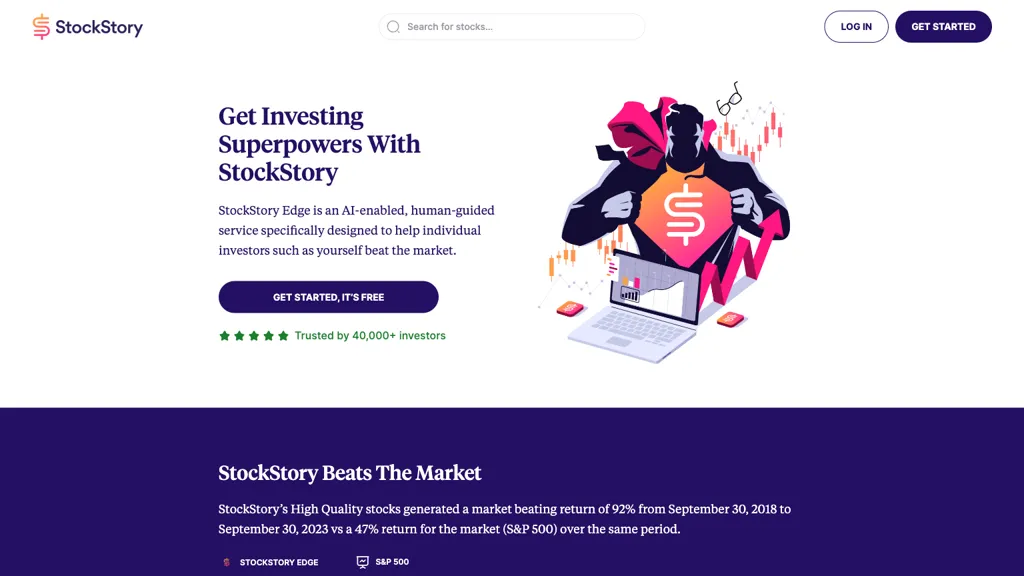20 New Ideas To Deciding On AI Stock Predictions Analysis Websites
20 New Ideas To Deciding On AI Stock Predictions Analysis Websites
Blog Article
Top 10 Tips To Customize Ai Trading Platforms To Your Strategy
Strategy customization is a crucial characteristic of AI trading platforms that predict and analyze stocks, as it allows users to adapt the platform to their own specific goals in trading as well as their risk tolerance and market conditions. A platform offering a range of customizable options can help you improve your trading. Here are 10 top tips for evaluating the customization options of these platforms.
1. Evaluate Pre-Built Strategy Templates
The variety of templates available: Check whether the platform has an array of built-in trading strategies (e.g. day trading and swing investing, as well as long-term investments).
You are able to easily modify the templates to adapt them to meet your needs.
Performance history: Check if the platform offers historical performance data on pre-built strategy.
2. Create a Custom Strategy
Drag-and-drop: Search for platforms that provide drag-and-drop interfaces for creating custom strategies.
Coding options: Determine if the platform supports custom programming (e.g., Python, R, or proprietary scripting languages) for advanced users.
Flexibility - Ensure that the platform you select permits you to define rules for entry and exit, as well as parameters for risk management, and other important aspects of your strategy.
3. Check for Backtesting Capabilities
Historical data. Check if the platform is able to provide enough historical data to test your strategy back.
Customizable settings: Be sure to have the ability to modify settings during backtesting.
Performance metrics: See if the platform provides precise measurement of performance (e.g., win rate Sharpe ratio, drawdown) to back-test strategies.
4. Evaluate Real-Time Strategy Testing
Paper trading Strategies can be tested in real-time with simulation or paper trading.
Live testing: Determine if you are able to test your strategies in real market conditions with small amounts of capital.
Real-time adjustments: Verify whether strategies can be modified in real-time, based on market conditions.
5. Integrate integration with technical indicators
Indicator library: Check if a platform provides a comprehensive collection of technical indicators, including moving averages (e.g. RSI), MACD, or RSI.
Custom indicators. Make sure you have the ability to develop or utilize custom indicators to your plan.
Combination of indicators Check whether the platform supports combining multiple indicators for complicated strategies.
6. Check for Risk Management Tools
Stop-loss/take-profit: Ensure the platform allows you to set stop-loss and take-profit levels within your strategies.
Sizing your positions. Verify whether you have established rules for how to manage the risk (e.g. an amount that is set or percentage of your portfolio).
Risk-reward ratio: Determine whether the platform can set risk-reward ratios for specific strategies or trades.
7. Evaluate Multi-Asset Strategy Support
Asset Classes: Make sure that the platform can support strategies for a variety of asset types (e.g. ETFs, Options, Forex, Stocks).
Strategies that cross assets: You could develop strategies that incorporate various asset types (e.g. pair trading, hedges).
Market coverage - Verify that the platform covers the markets in which you are in (e.g. US and international markets and copyright and more.).
8. Evaluate the automation, Execution and Execution
Automated Trading: Verify that the platform can execute strategies automatically that are based on predefined rules.
Order types: Find out whether the platform supports different kinds of orders (e.g. limit, market stop, limit) to execute a strategy.
Latency - Verify the ability of the platform to execute trades on time particularly when you are using high frequency strategies.
9. Check out the Strategy Optimization Tools
Optimization of parameters: Make sure the platform provides tools to optimize strategy parameters (e.g., grid search or genetic algorithms).
Machine Learning Integration: Find out whether a platform is able to integrate machine learning to refine and optimize strategy.
Analyze scenarios: Determine if the platform lets you test various strategies under different market scenarios (e.g. bear, bull volatile).
Review User Comments
Feedback from users: Use user feedback to evaluate the efficiency of the platform in determining customizing strategies.
Community forums: See if you can find forums where users can discuss and share their custom strategies.
Support resources - Make sure that the platform has instructions and documents to help users create and enhance strategies.
Bonus Tips
Trial period for free: You are able to try out the customizable options of the platform with a an online demo or a trial period for free.
Scalability: The platform should be able to support increasingly complex trading strategies as you develop.
Support for customers: Find out if the platform offers assistance for issues related to strategy or questions.
Use these guidelines to evaluate the AI stock predicting/analyzing platforms' ability to customize strategies. If you do this, you will ensure that you select a platform that is compatible with your objectives for trading and enables you to develop and improve your own strategies. A platform that offers powerful customization options will allow you to adapt to changing market conditions and improve the performance of your trading. Read the top rated stock ai hints for more recommendations including best ai trading app, chatgpt copyright, ai trading tools, investment ai, ai trade, ai for investing, ai chart analysis, best ai trading app, ai investing, incite and more.
Top 10 Tips For Evaluating The Speed And Latency Of Ai Trading Platforms
Latency and speed are crucial aspects to consider when evaluating AI stocks and analyzing trading platforms, particularly for active traders, algorithmic traders, as well as high-frequency traders. A delay of just milliseconds can affect the execution of trades and profit. Here are the top 10 tips for evaluating the latency and speed of these platforms.
1. Real-time data feeds to be analyzed
Data delivery speed - Ensure that the platform will provide real-time data with a minimum delay (e.g. the sub-millisecond delay).
Closeness of the data source: Find out the location of servers close to major exchanges.
Data compression: Determine whether your platform uses efficient data compression techniques in order to accelerate data delivery.
2. Check the trade execution speed
Order processing time: Measure how quickly the platform process and executes trades once you've submitted your order.
Direct Market Access: Make sure that the platform provides DMA. DMA is a feature which allows you to transmit orders directly to exchanges without intermediaries.
Execution reports. Make sure the platform offers comprehensive execution reports. These reports should include dates for order submission, confirmation, and fill.
3. Assess Platform Receptiveness
User interface (UI), speed: Test the platform’s response time to your inputs.
Chart updates: Check to see if the charts and visualizations are updated in real-time with no lag.
Performance of mobile apps. If you are using an app for mobile be sure that it is performing as quickly and smoothly as a desktop application.
4. Check for Low Latency Infrastructure
Locations of the servers: The platform should use high-speed, low-latency servers that are close to major exchanges or financial hubs.
Check for co-location alternatives. These services permit you to host your algorithm near the exchange.
High-speed networks - Verify that the platform uses fiber-optic high-speed network or other low-latency technology.
5. Evaluation of Backtesting and Simulation speed
Historical data processing: Test how quickly the platform processes and analyzes the historical data to backtest.
Platform latency should be low enough to permit real-time simulations of trades.
Parallel processing: Find out whether the platform uses parallel processing or distributed computation to speed complex calculations.
6. Calculate the API Latency
API response time: This is the speed at that an API platform responds to requests.
Rate limits: Ensure that the API is within reasonable limits for rates to prevent delays when high-frequency trading takes place.
WebSockets support: Verify that the platform utilizes WebSockets protocols for low-latency real-time streaming of data.
7. Test the stability of the platform under load
High volume trading scenarios Check the stability of the platform and its responsiveness by simulating trading scenarios.
Test your platform in periods of extreme market volatility.
Test for stress: Check whether your platform offers the tools to test stress-testing strategies in extreme conditions.
8. Examine the network and connectivity
Internet speed requirements: To ensure maximum performance, ensure that your internet speed meets the recommended speed for your platform.
Reliable Connections: To prevent downtime, check if your platform supports redundant internet connections.
VPN latency. If you are using a VPN look to see whether it causes an excessive amount of latency.
9. Look for features to speed up your performance.
Pre-trade analytics - Ensure that the platform has pre-trade analytical tools that can help optimize the routing of orders.
Smart Order Routing (SOR). Verify that the platform uses SOR in order to locate the quickest and most cost efficient execution sites.
Monitoring latency: Check that the platform offers tools to monitor and analyze the latency in real time.
Review User Feedback Benchmarks
Reviews from users: Perform research to assess the platform's speed and latency.
Third-party benchmarks by third parties. You can find benchmarks from independent sources or reviews that assess a platform's speed with other platforms.
Case studies: Verify if a platform has case studies or testimonies that highlight the low-latency features.
Bonus Tips:
Trial period: Take advantage of an unpaid trial or demo to evaluate the platform's performance and latency in actual scenarios.
Support for customer - Make sure there is support available to address issues relating to latency, optimization, or any other issue.
Hardware specifications. Make sure the platform is compatible with the hardware you are using, such as high-performance computers.
With these suggestions using these tips, you will be able to be able to accurately evaluate the speed, latency, and the accuracy of AI software for analyzing and predicting stocks. This will allow you to select a platform based on your trading requirements and minimize any possible delays. Low latency can be crucial for high-frequency or algorithmic traders where even small delays can be a significant factor in their profitability. Follow the best how to use ai for stock trading blog for more examples including best stock prediction website, best ai stocks to buy now, ai for trading stocks, ai stock trader, free ai stock picker, how to use ai for copyright trading, stocks ai, ai share trading, ai stock prediction, ai stock analysis and more.